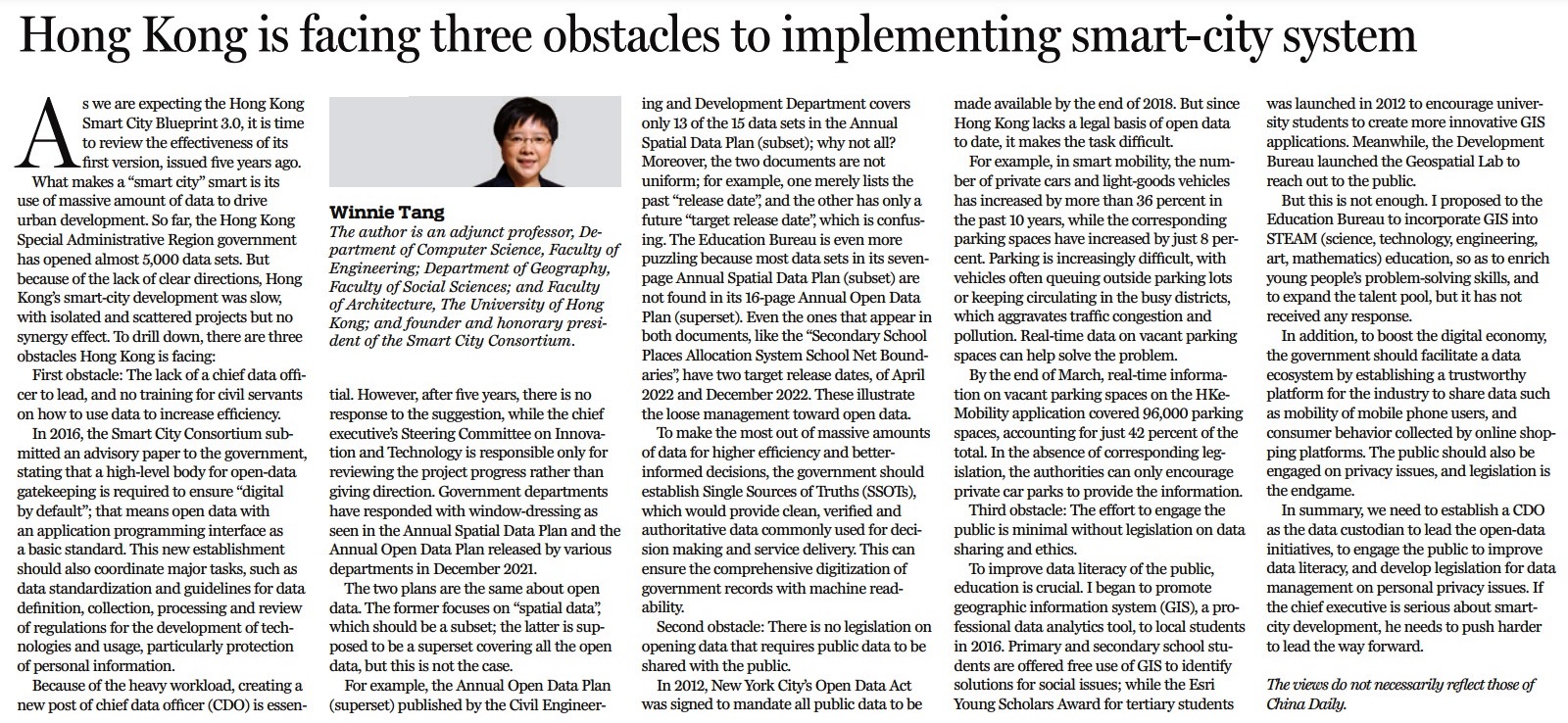網上版請按此

Hong Kong is facing three obstacles to implementing smart-city system
As we are expecting the Hong Kong Smart City Blueprint 3.0, it is time to review the effectiveness of its first version, issued five years ago.
What makes a "smart city" smart is its use of massive amount of data to drive urban development. So far, the Hong Kong Special Administrative Region government has opened almost 5,000 data sets. But because of the lack of clear directions, Hong Kong's smart-city development was slow, with isolated and scattered projects but no synergy effect. To drill down, there are three obstacles Hong Kong is facing:
First obstacle: The lack of a chief data officer to lead, and no training for civil servants on how to use data to increase efficiency.
In 2016, the Smart City Consortium submitted an advisory paper to the government, stating that a high-level body for open-data gatekeeping is required to ensure "digital by default"; that means open data with an application programming interface as a basic standard. This new establishment should also coordinate major tasks, such as data standardization and guidelines for data definition, collection, processing and review of regulations for the development of technologies and usage, particularly protection of personal information.
Because of the heavy workload, creating a new post of chief data officer (CDO) is essential. However, after five years, there is no response to the suggestion, while the chief executive's Steering Committee on Innovation and Technology is responsible only for reviewing the project progress rather than giving direction. Government departments have responded with window-dressing as seen in the Annual Spatial Data Plan and the Annual Open Data Plan released by various departments in December 2021.
The two plans are the same about open data. The former focuses on "spatial data", which should be a subset; the latter is supposed to be a superset covering all the open data, but this is not the case.
For example, the Annual Open Data Plan (superset) published by the Civil Engineering and Development Department covers only 13 of the 15 data sets in the Annual Spatial Data Plan (subset); why not all? Moreover, the two documents are not uniform; for example, one merely lists the past "release date", and the other has only a future "target release date", which is confusing. The Education Bureau is even more puzzling because most data sets in its seven-page Annual Spatial Data Plan (subset) are not found in its 16-page Annual Open Data Plan (superset). Even the ones that appear in both documents, like the "Secondary School Places Allocation System School Net Boundaries", have two target release dates, of April 2022 and December 2022. These illustrate the loose management toward open data.
To make the most out of massive amounts of data for higher efficiency and better-informed decisions, the government should establish Single Sources of Truths (SSOTs), which would provide clean, verified and authoritative data commonly used for decision making and service delivery. This can ensure the comprehensive digitization of government records with machine readability.
Second obstacle: There is no legislation on opening data that requires public data to be shared with the public.
In 2012, New York City's Open Data Act was signed to mandate all public data to be made available by the end of 2018. But since Hong Kong lacks a legal basis of open data to date, it makes the task difficult.
For example, in smart mobility, the number of private cars and light-goods vehicles has increased by more than 36 percent in the past 10 years, while the corresponding parking spaces have increased by just 8 percent. Parking is increasingly difficult, with vehicles often queuing outside parking lots or keeping circulating in the busy districts, which aggravates traffic congestion and pollution. Real-time data on vacant parking spaces can help solve the problem.
By the end of March, real-time information on vacant parking spaces on the HKeMobility application covered 96,000 parking spaces, accounting for just 42 percent of the total. In the absence of corresponding legislation, the authorities can only encourage private car parks to provide the information.
Third obstacle: The effort to engage the public is minimal without legislation on data sharing and ethics.
To improve data literacy of the public, education is crucial. I began to promote geographic information system (GIS), a professional data analytics tool, to local students in 2016. Primary and secondary school students are offered free use of GIS to identify solutions for social issues; while the Esri Young Scholars Award for tertiary students was launched in 2012 to encourage university students to create more innovative GIS applications. Meanwhile, the Development Bureau launched the Geospatial Lab to reach out to the public.
But this is not enough. I proposed to the Education Bureau to incorporate GIS into STEAM (science, technology, engineering, art, mathematics) education, so as to enrich young people's problem-solving skills, and to expand the talent pool, but it has not received any response.
In addition, to boost the digital economy, the government should facilitate a data ecosystem by establishing a trustworthy platform for the industry to share data such as mobility of mobile phone users, and consumer behavior collected by online shopping platforms. The public should also be engaged on privacy issues, and legislation is the endgame.
In summary, we need to establish a CDO as the data custodian to lead the open-data initiatives, to engage the public to improve data literacy, and develop legislation for data management on personal privacy issues. If the chief executive is serious about smart-city development, he needs to push harder to lead the way forward.
Dr. Winnie Tang
Adjunct Professor, Department of Computer Science, Faculty of Engineering; Department of Geography, Faculty of Social Sciences; and Faculty of Architecture, The University of Hong Kong